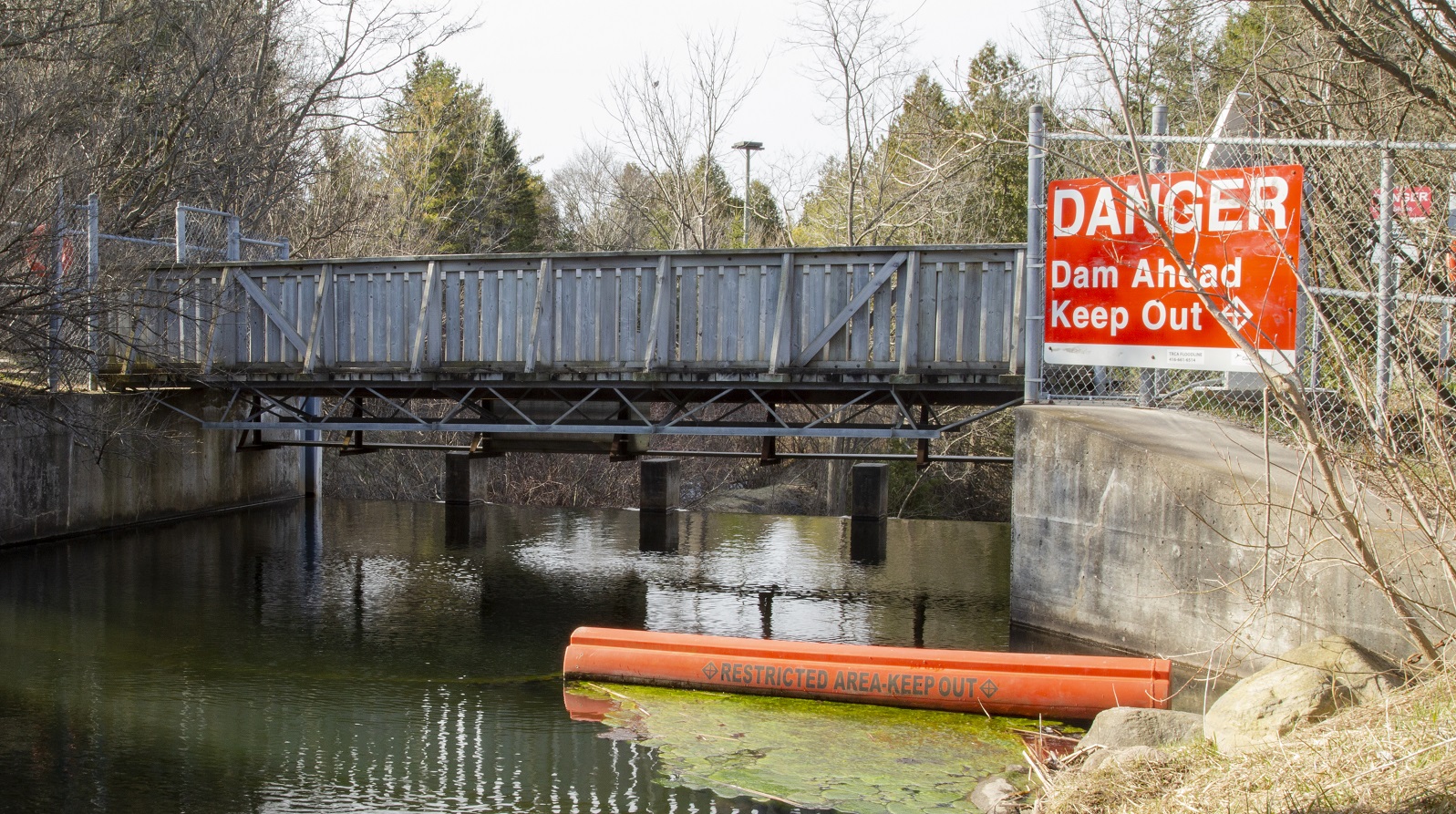Toronto and Region Conservation Authority (TRCA) operates dams and other flood control structures across its jurisdiction. Always exercise caution when you are in the vicinity of these structures.

Water level and flow around these structures can change rapidly. Dam operators may change how much water passes through a dam at any time — without warning — making the area downstream hazardous.
This can happen even during periods of dry weather. A change in the amount of water released by a dam can have an impact for many kilometres downstream.
Stay off dam structures unless an area is clearly marked for public travel. These structures were created for specific purpose and only qualified personnel are allowed on the structures.
Be alert to changes in water levels any time you are near a river or creek.

How to Stay Safe
Here are some tips to help you stay safe near TRCA’s flood control infrastructure:
- If there is an emergency, call 911 immediately.
- Obey all warning signs and respect fenced, marked, and gated areas, including those that indicate private property. They are there to keep you safe.
- Supervise children at all times and keep pets on a leash.
- Stay a safe distance away from reservoirs and riverbanks that could have unstable footing or slippery banks.
- Swimming is not permitted. Swimming in the reservoir above the dams or in the river below the dams is extremely dangerous.
- Beware of thin ice that may develop in rivers and reservoirs due to dam operations. Never venture out on the ice.
- Boating around dams can be extremely dangerous. Avoid boating on dam reservoirs if possible and be observant of dam intakes. Dam intakes are marked with signs and orange safety booms. Stay away from dam intakes and spillways.
- Fishing near dams is not permitted.
Throughout TRCA’s jurisdiction there are also dozens of low head dams and weirs located in rivers and creeks. They can be extremely dangerous at any water level, trapping people and pets. It is important to stay away from these structures.
More Information on Dam Safety
Seasonal Safety Tips
|
WINTER:
|
|
|
SPRING:
|
|
|
SUMMER:
|
|
|
FALL:
|
Dam Hazards
Regardless of their size, type or intended use, all dams present certain hazards to those who work or play near them. Pay attention to signs, booms, buoys, and fencing.
- Booms are installed to warn river users that the area near a dam is hazardous and to stay back.
- Buoys are used instead of booms where river flows and river debris can cause damage.
DAM HAZARDS: Low Head Weirs
- While low head weirs may appear insignificant, they pose considerable dangers to those boating or playing around them.
- Water that continuously re-circulates at the base of low head weirs creates underwater hydraulics which can easily trap someone underwater at the base of the dam.
- Low head weirs may have no visible structure above the water line (boaters approaching a weir from the upstream side may not be aware of the dangers present).
- Always watch for and obey signs, booms, buoys, and portage markers.
DAM HAZARDS: Water Conditions
- Upstream dam leakage between and around stop logs can pull swimmers in and drag them below the water level with such force that they can’t escape.
- Air trapped in water reduces your buoyancy (if you’re caught in foaming water, you will find it harder to stay afloat even with the aid of personal flotation gear).
- Changing water levels and flows below a dam can occur rapidly and without warning.
- Never place yourself in a situation where you can’t leave the area you are boating in.
- Never camp, picnic, or sunbathe in an area below a dam that may become flooded
DAM HAZARDS: Retaining Walls
- Concrete retaining walls above and below dams can block exit routes. These are often present near marine locks.
Resources
RESOURCES ON DAM SAFETY
- Canadian Dam Association
- Ministry of Natural Resources and Forestry: Dam Management
- Association of State Dam Safety Officials (ASDSO)
- Ontario Power Generation
WHO REGULATES DAM SAFETY?
In Ontario there are two main bodies that provide guidance on dam safety:
- Ministry of Natural Resources and Forestry
- Under the Lake and Rivers Improvement Act, there are technical bulletins that dam owners should follow. LEARN MORE.
- Canadian Dam Association (CDA)
- The Canadian Dam Association is a group of dam owners, operators, regulators, engineers, and others who share the goal of advancing knowledge and practices related to dams. All involved in all types of dams used for many different purposes: hydroelectric power, irrigation, flood control, water supply and mining operations. LEARN MORE.
TRCA FLOOD CONTROL INFRASTRUCTURE
TRCA owns and operates 12 dams, six dikes, and nine flood control channels within our jurisdiction. LEARN MORE.
REAL-TIME WATER LEVEL INFORMATION
TRCA has dozens of water level gauges on rivers and streams at important locations throughout the Greater Toronto Area as part of its Flood Forecasting and Warning Program.
Explore in-stream water levels at TRCA dams and river stations directly at TRCAgauging.ca.
QUICK LINKS



